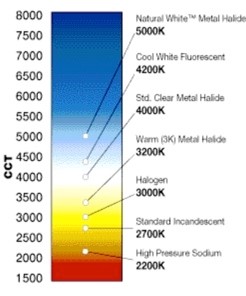Lighting installations within a retail environment require so much more thought and preparation than what it is often afforded. Did you know that lighting can impact a salesman’s productivity, a products’ appearance and a shopper’s perception of the store and its products?
In this NEW series, we give you a basic understanding of retail lighting, its importance and the many benefits of upgrading your lighting system…
Part 1 – Colour Rendering Index (CRI)
Part 2 – Correlated Colour Temperature (CCT) and the effects on products, shoppers and employees
Part 3 – The types of lighting in a retail store
Understanding Correlated Colour Temperature
Correlated colour temperature (CCT) defines the colour appearance of a white light emitted by a light. The unit of measurement for CCT is Kelvin. Different temperatures on the Kelvin scale represent various colours. Light in the CCT range of 2000K-3500K looks more orange/yellow, and is referred to as warm white, whilst CCT ranges between 3500K and 5100K are referred as neutral white. Any light bulb with a CCT range greater than 5100K is referred to as cool white.
The figure below depicts both the Yellow and Blue range of the CCT spectrum, with their respective Kelvin Units.
Interesting to note are the results from a study conducted by the Royal Institute of Technology in Sweden. Their research indicated that a lights’ colour temperature led customers to certain products and parts of the store.
The table below indicates the CCT range to consider when illuminating various areas.
Effects of lighting on products
The advantages of properly illuminating products in a store are:
- Lighting has the ability to make a product aesthetically pleasing.
- Well-lit products have the ability to appeal to a customer’s senses.
- Lighting implemented correctly will highlight a product.
- Lighting has the ability to create hierarchy amongst products.
Effects of Lighting on the shelf life of products
Ordinary lighting used to illuminate fresh food will cause a decline in the quality and safety of it. The heat and light radiation that is given off by the light will cause the food to undergo adverse changes that affects the appearance, shelf life, taste and food safety.
Perishable products such as meat, seafood, cheeses, produce and bakery items are impacted negatively when illuminated by non-food specific lighting. It influences the colour, rate of spoilage, flavour and smell of the product.
Specific LED lamps are designed with a blend of phosphors and a specific number of coatings to provide colour definition and protection to perishable foods.
Effects of lighting on Shoppers
The illumination of a retail environment should ensure that the customers’ shopping experience is both efficient and pleasant. Lighting attracts customers’ attention to the products and successful lighting influences their emotions, increases their satisfaction and desire to shop. Positive thoughts and memories are created when a customer is happy and relaxed in a store, which is likely to make them return. Dim lighting used in a store sets a relaxed tone by slowing down the pace at which customers shop, and instills a sense of calm.
Research performed by scientists from the University of Hamburg indicated that a customer’s eyes gravitated towards areas of contrasting light instead of brightly lit regions.
Contrasting lights are used to create a spatial atmosphere and highlight merchandise in an environment. This is done by illuminating certain surfaces whilst surrounding areas are in a comparative darkness. Ambient and accent lighting are used to ensure that the contrasting light effects are obtained. The use of both ambient and accent lighting produces different contrasts, which can draw customers’ attention and raise environmental satisfaction. Low contrast lighting is implemented to provide easy task vision, allow random circulation and permit flexible relocation of work surfaces. High contrast lighting is used to increase stimulation in an area, to evoke feelings of excitement and produce a special atmosphere.
Effect of Lighting on Employees
Lighting in a workplace has the ability to impact an employee’s concentration and productivity. Proper lighting in the workplace has been found to decrease depression, improve attitude and increase the energy levels of a person. It can also positively influence the mood, alertness and productivity of an individual.
A study conducted by Philips, indicated that there is a link between light and the circadian rhythms of an individual. These circadian rhythms are referred to as “built in clocks” that influences the sleep cycle, relaxation and stimulation of an individual.
If improper lighting is implemented in a workplace, it results in a range of ill-health effects. These ill-health effects could be both physical and mental. Examples of these are eye strains, fatigue and also stress and anxiety. Poor lighting in a workspace can also result in employees experiencing headaches due to the strain that is put on their eyes.
We wrap up our series with the third instalment - The types of lighting and implementation. Be sure to read the entire series!
Resources:
1. LEARN more about lighting here
2. DOWNLOAD our lighting catalogue
3. CHAT to our lighting experts




